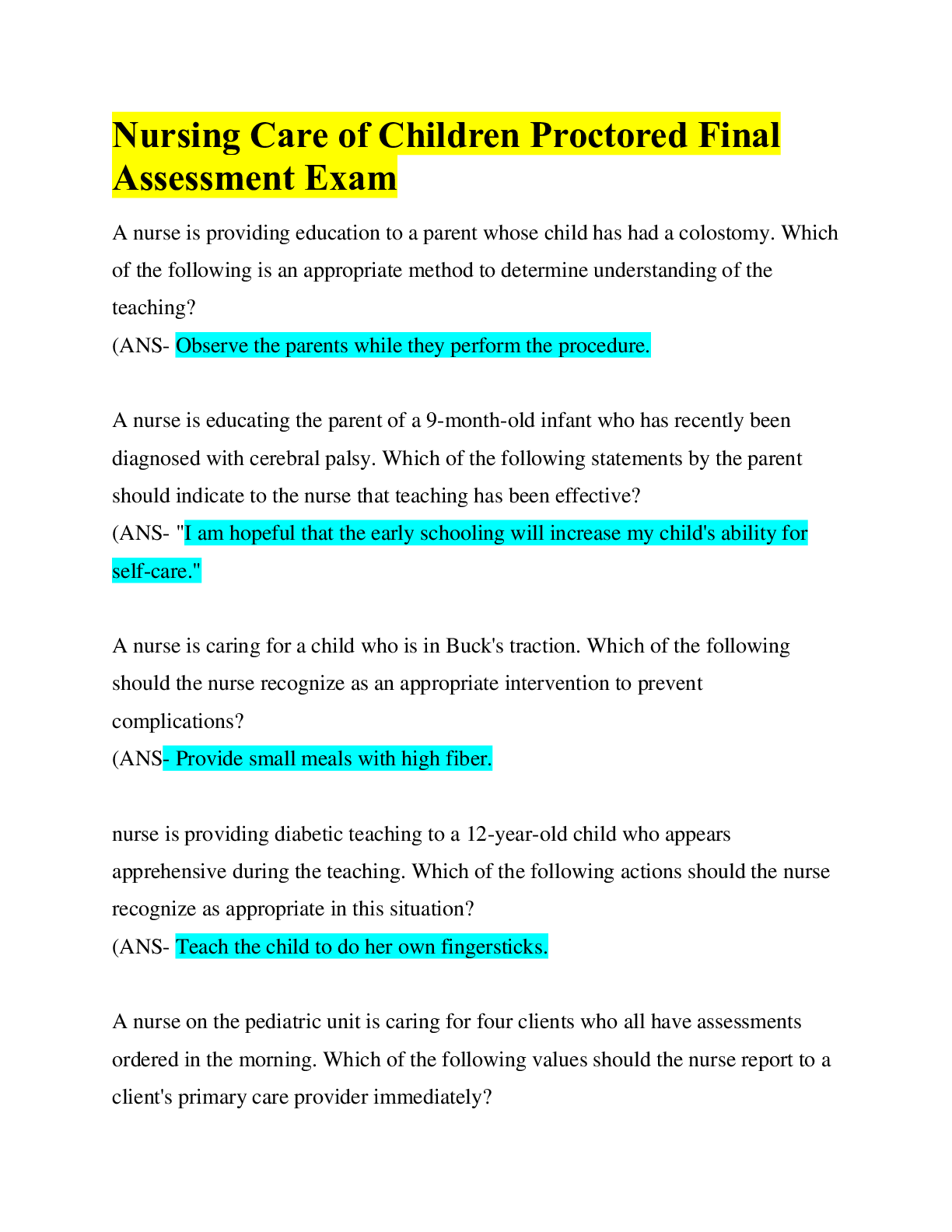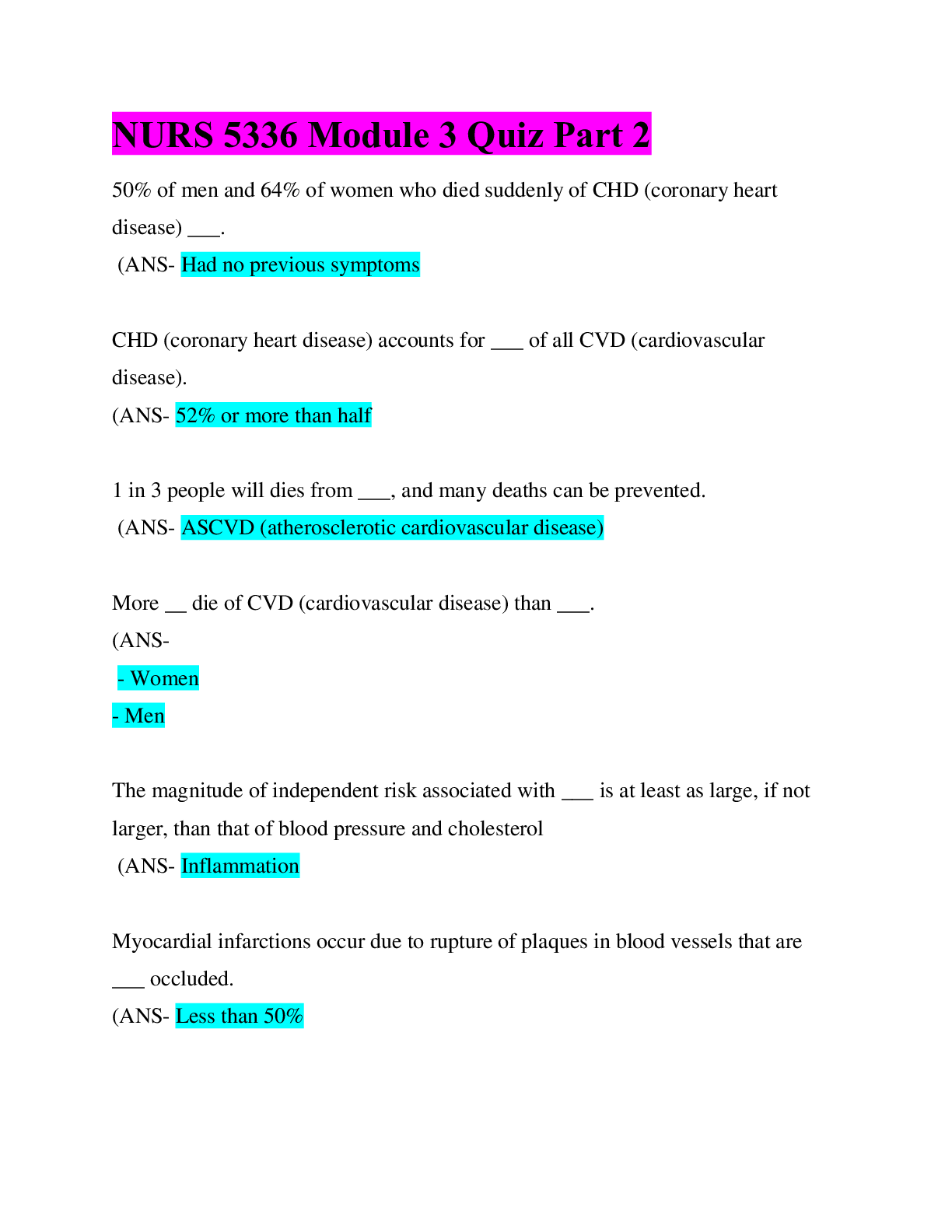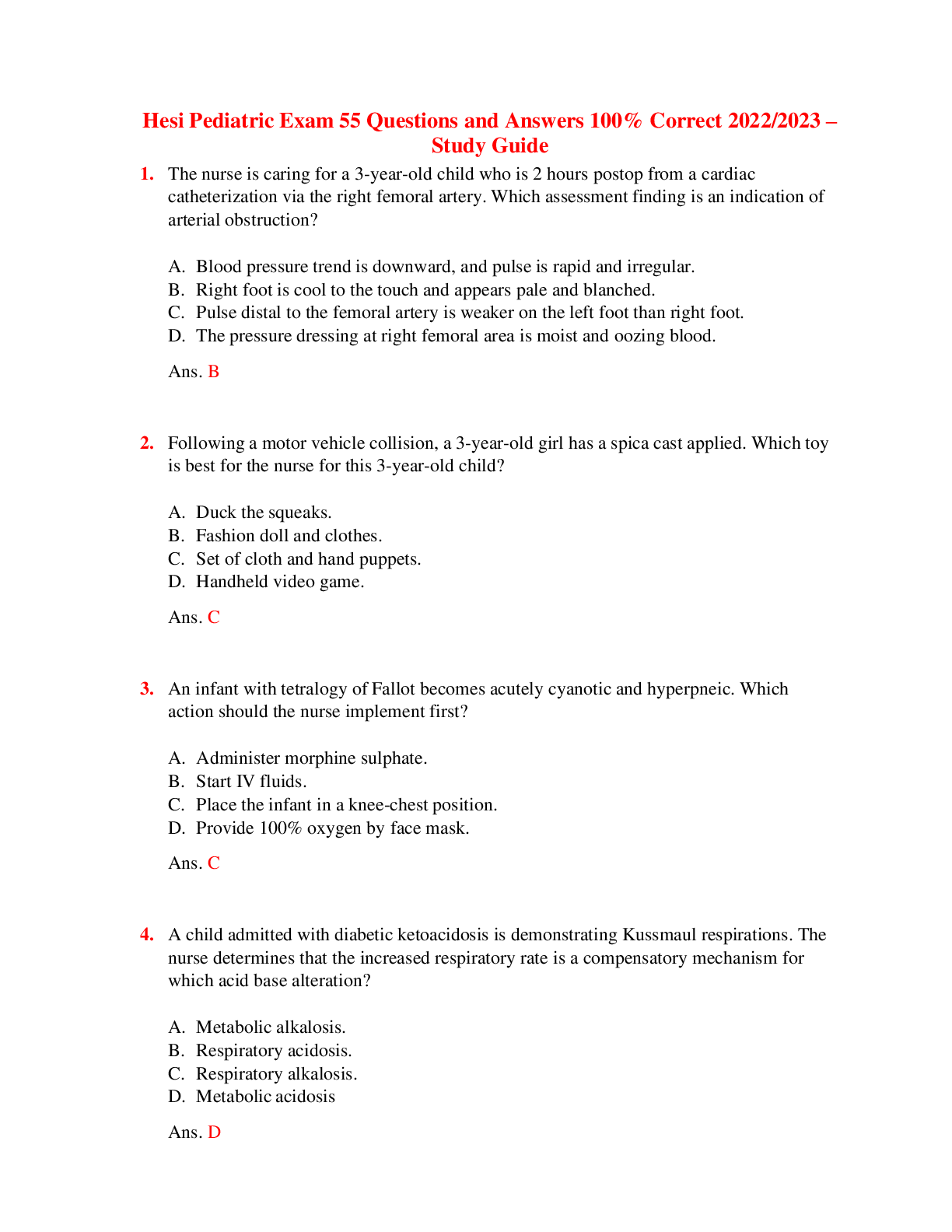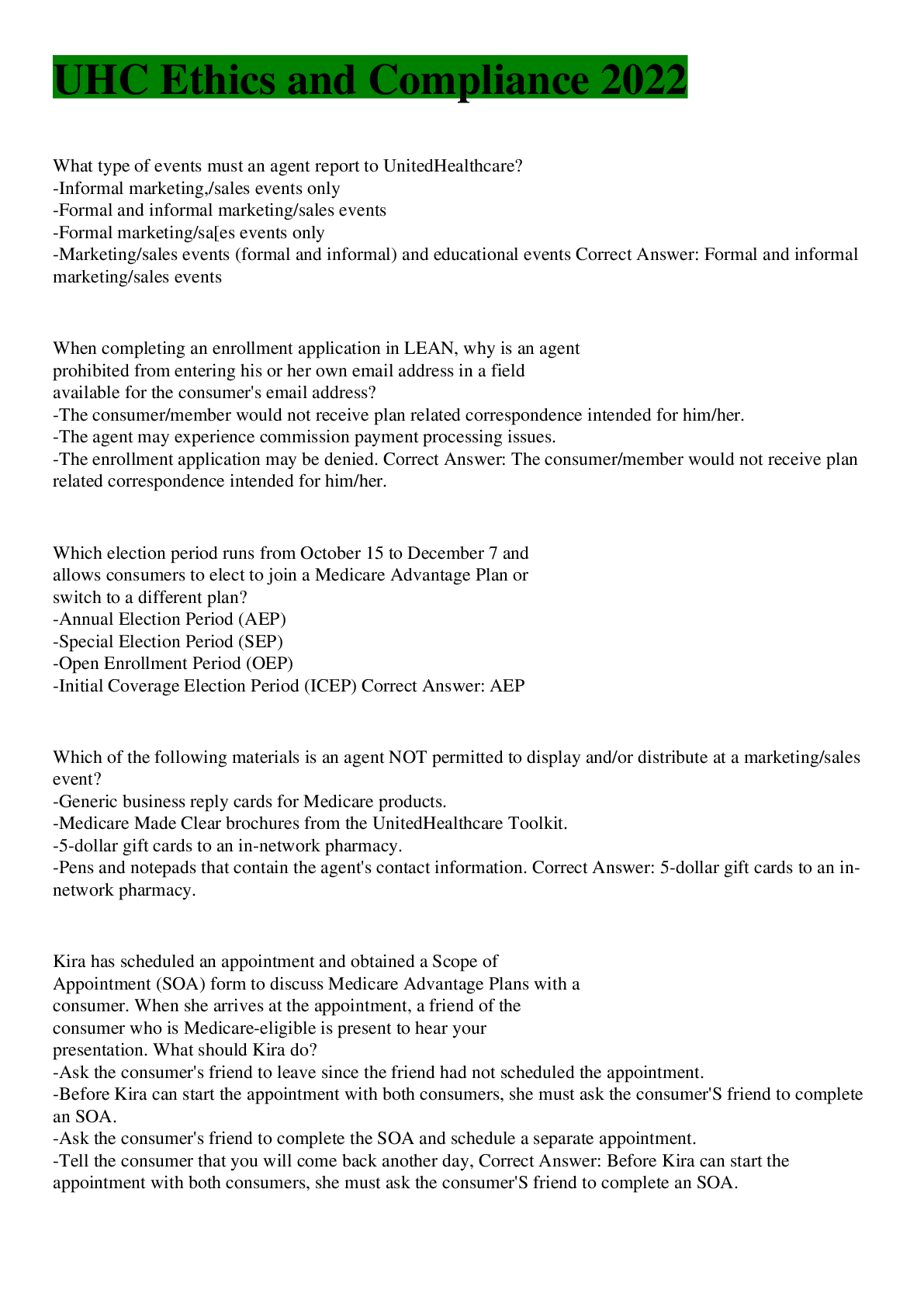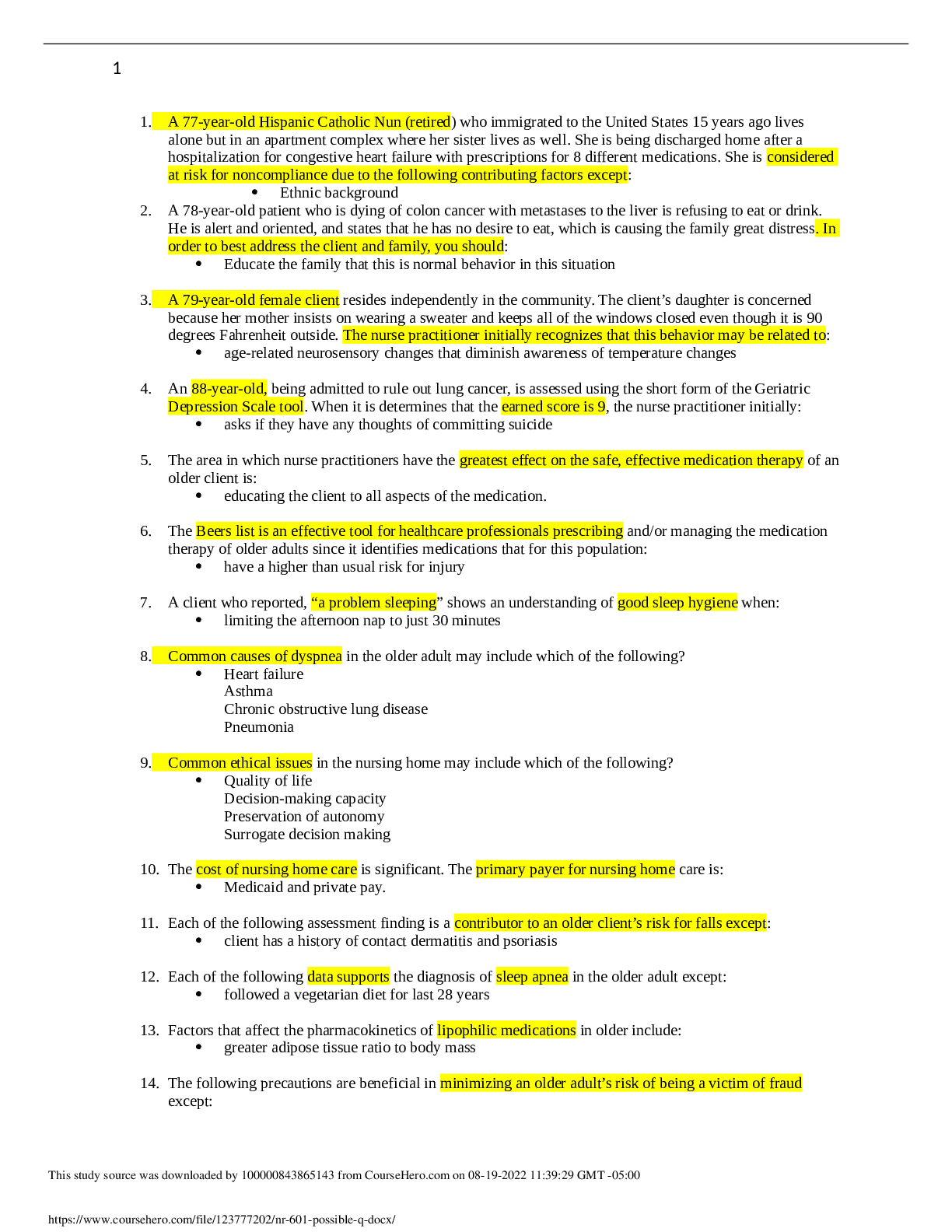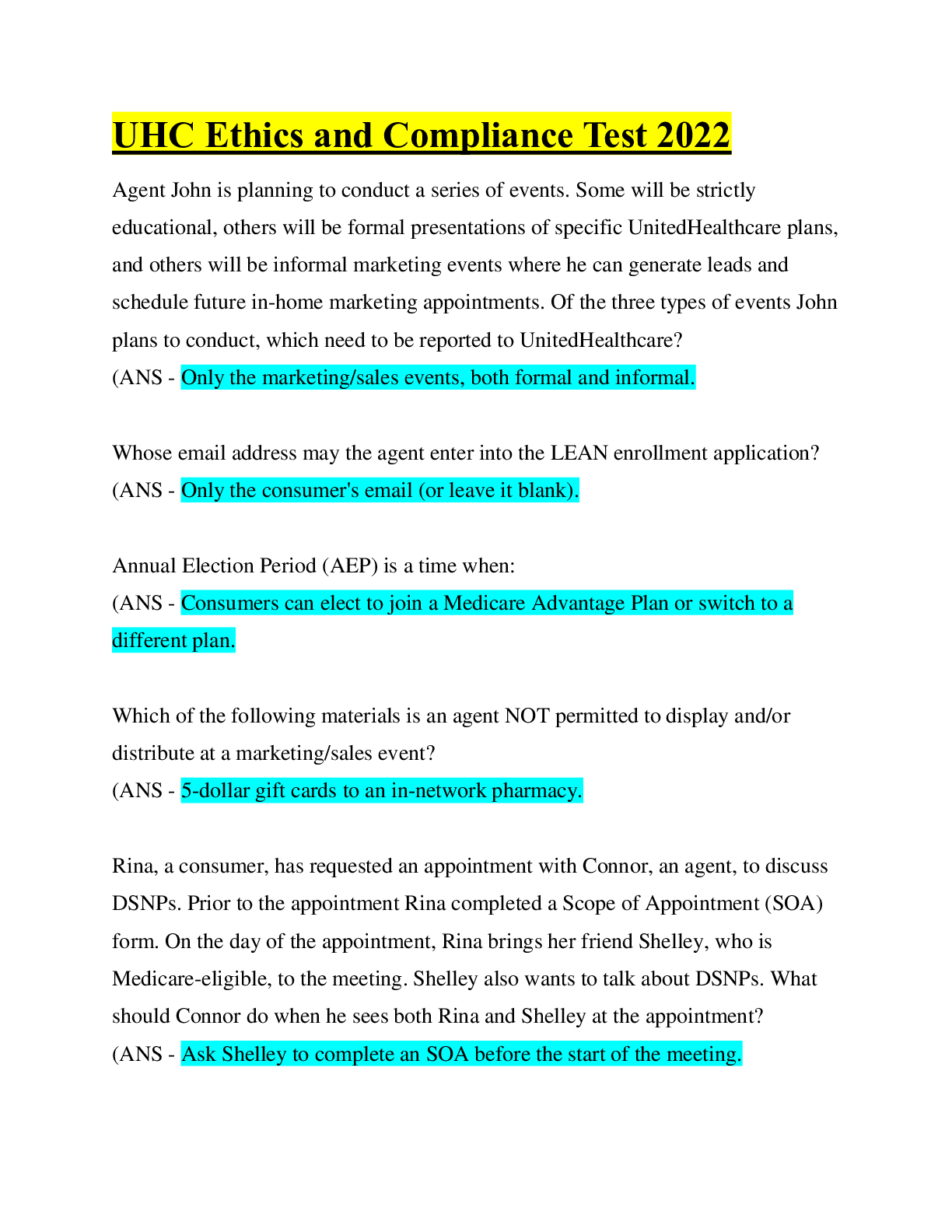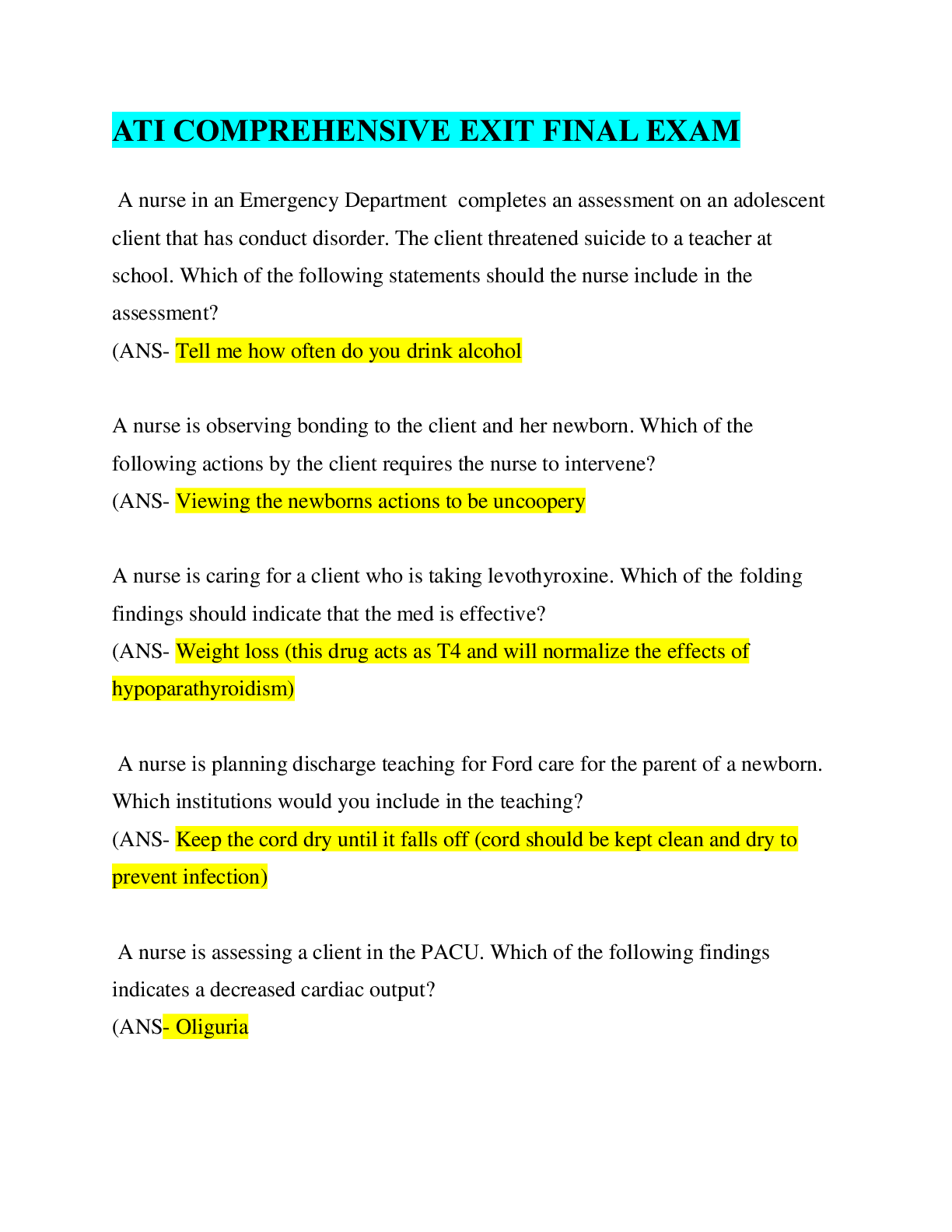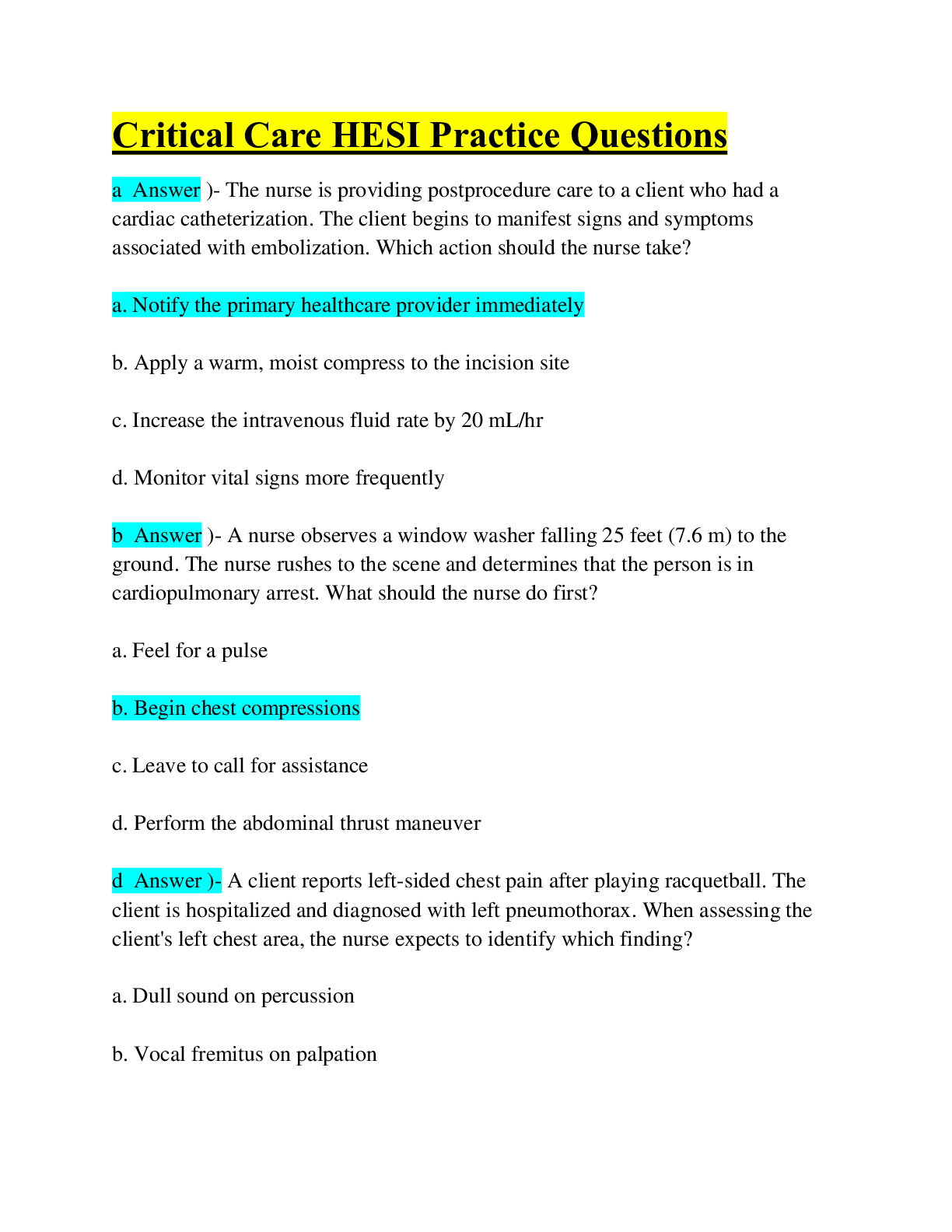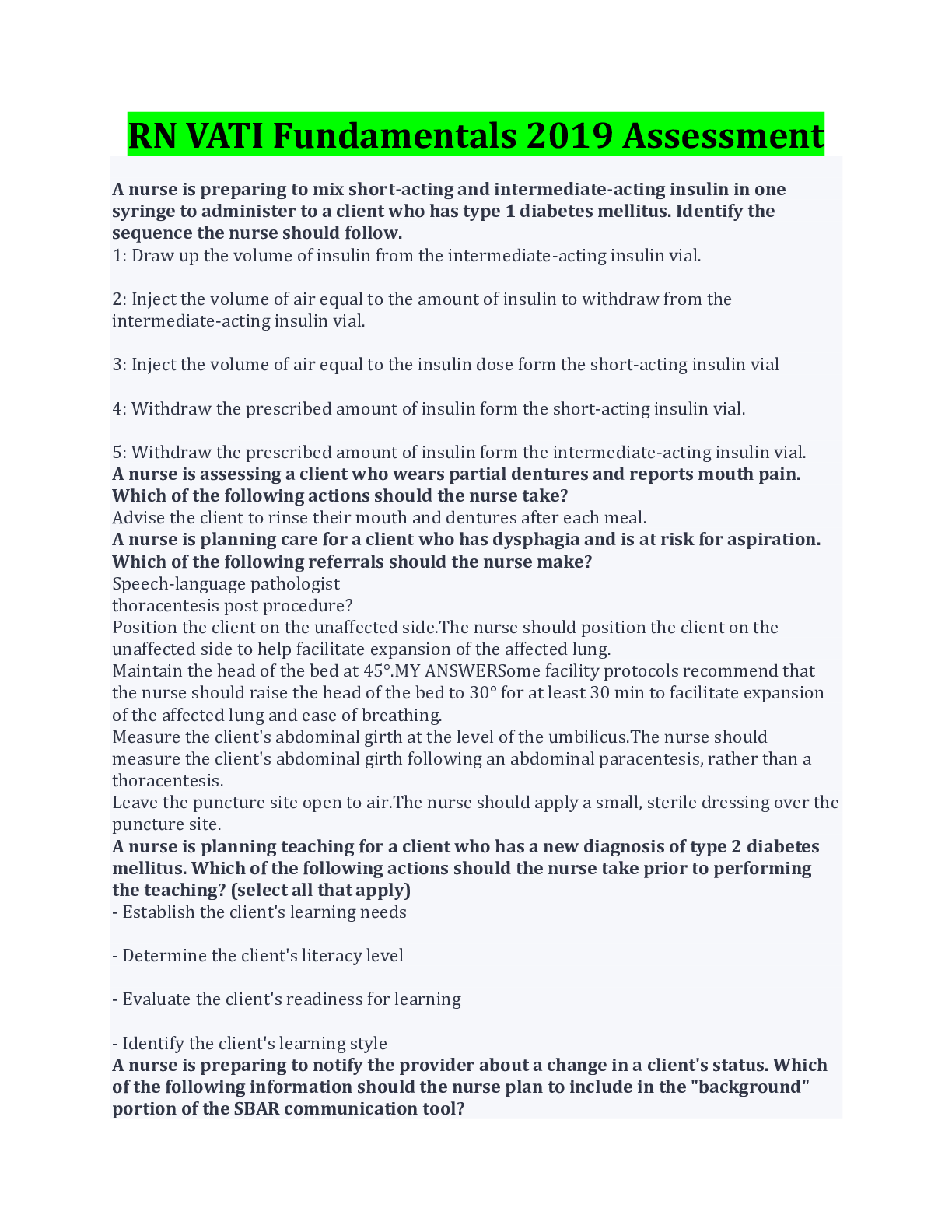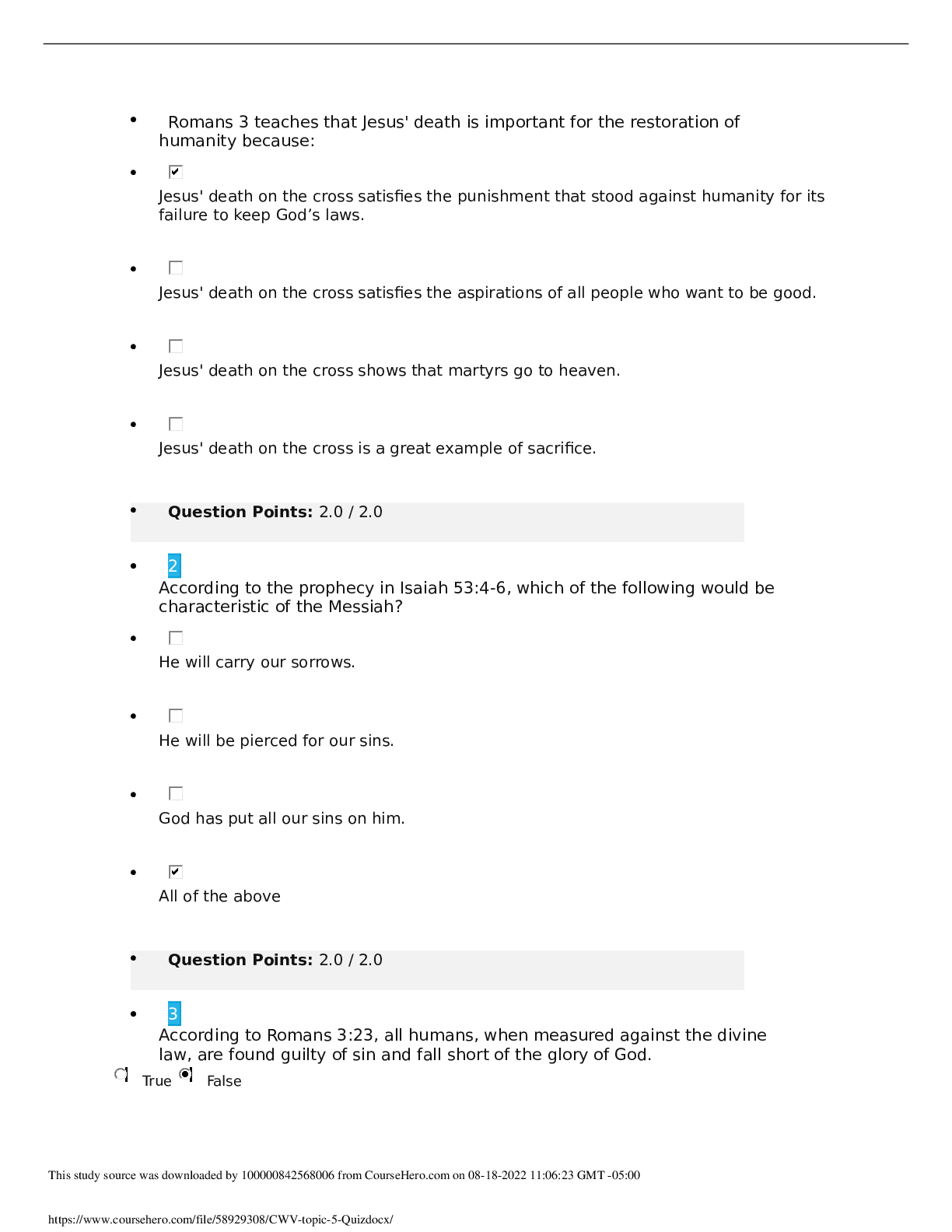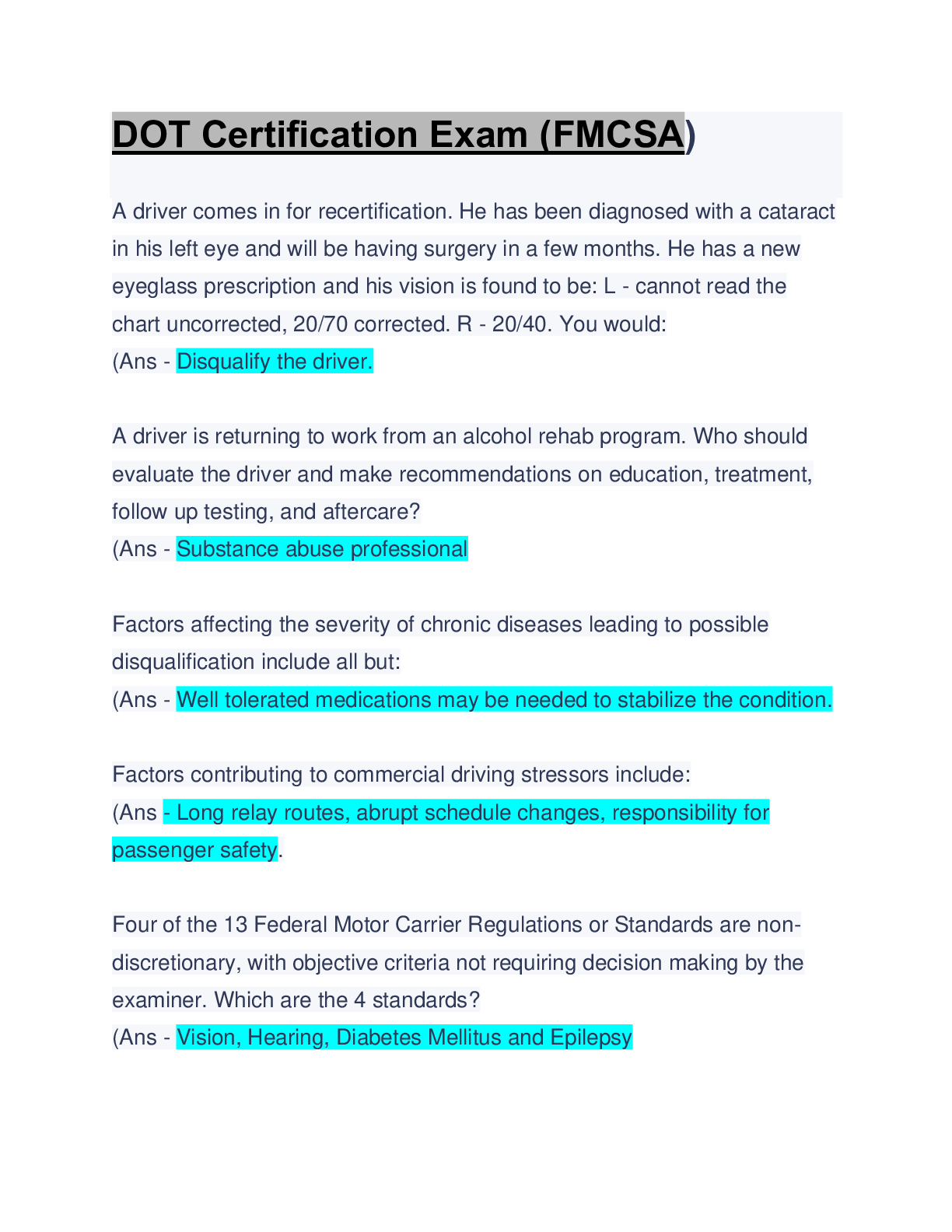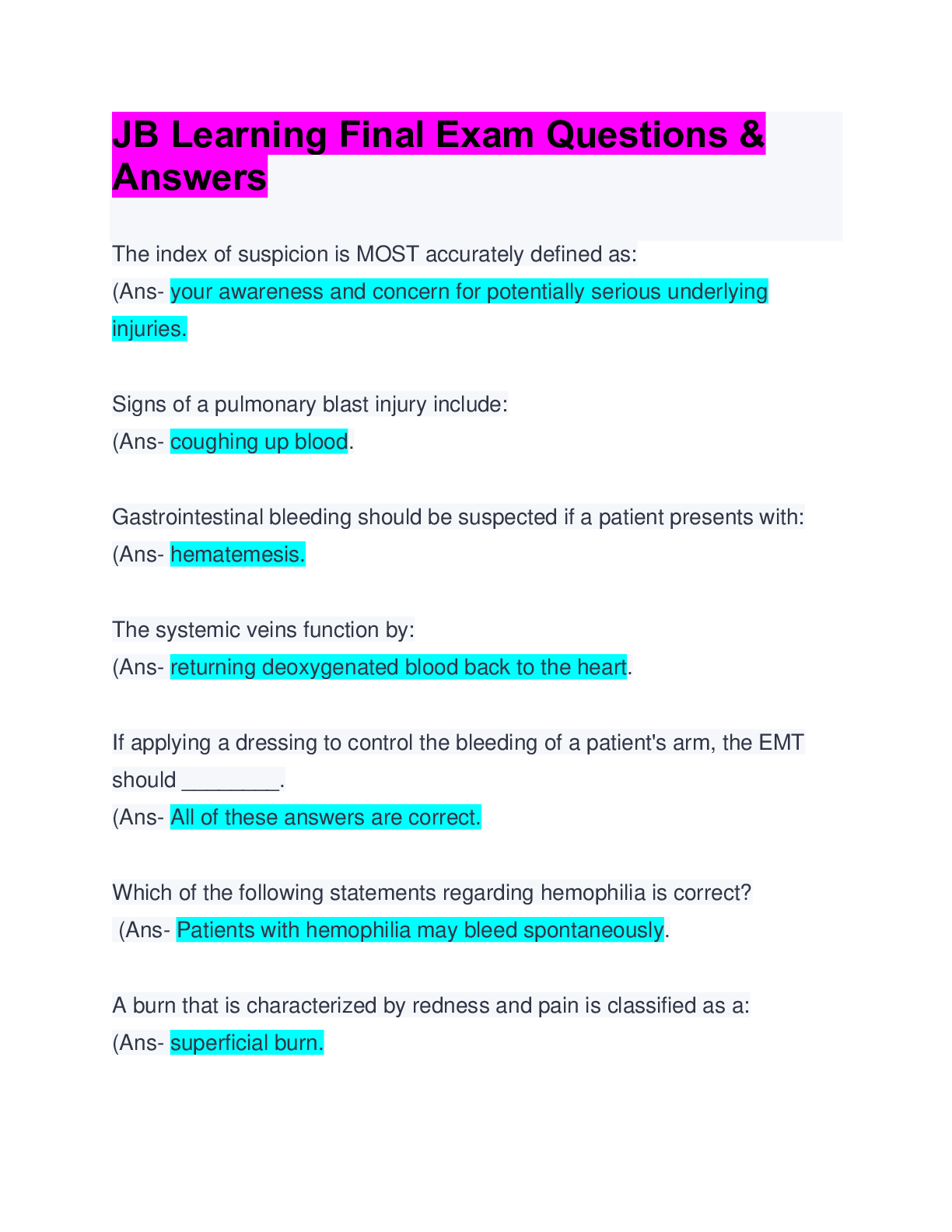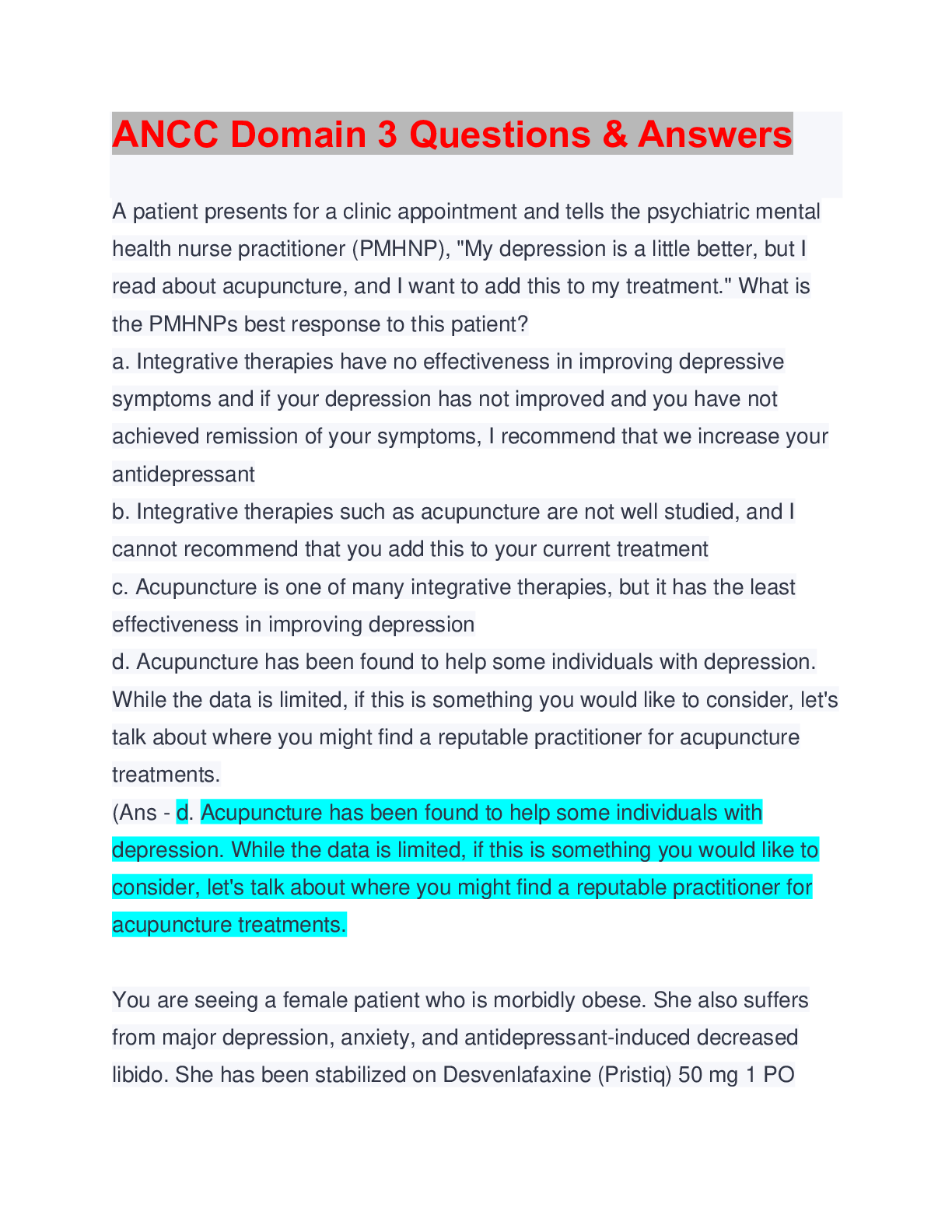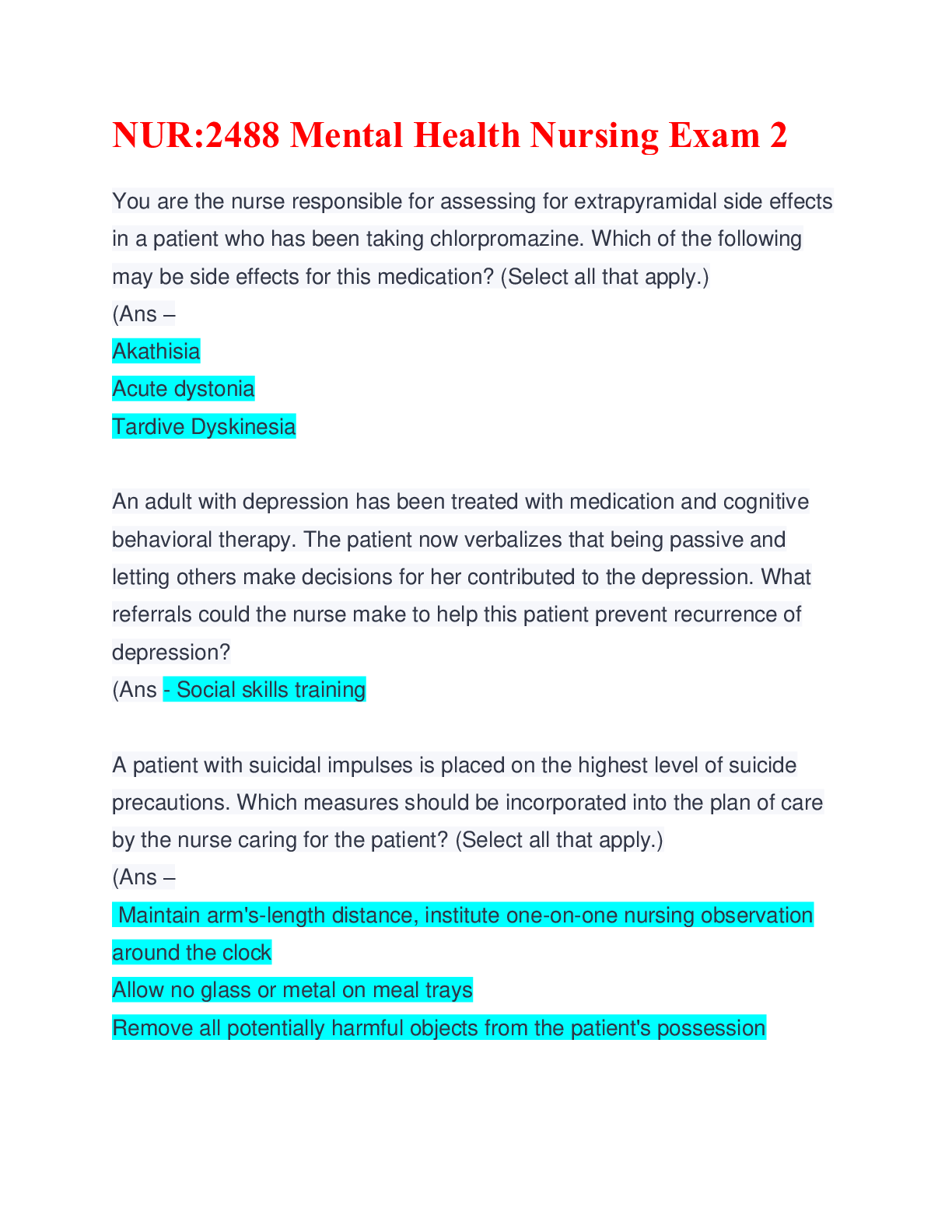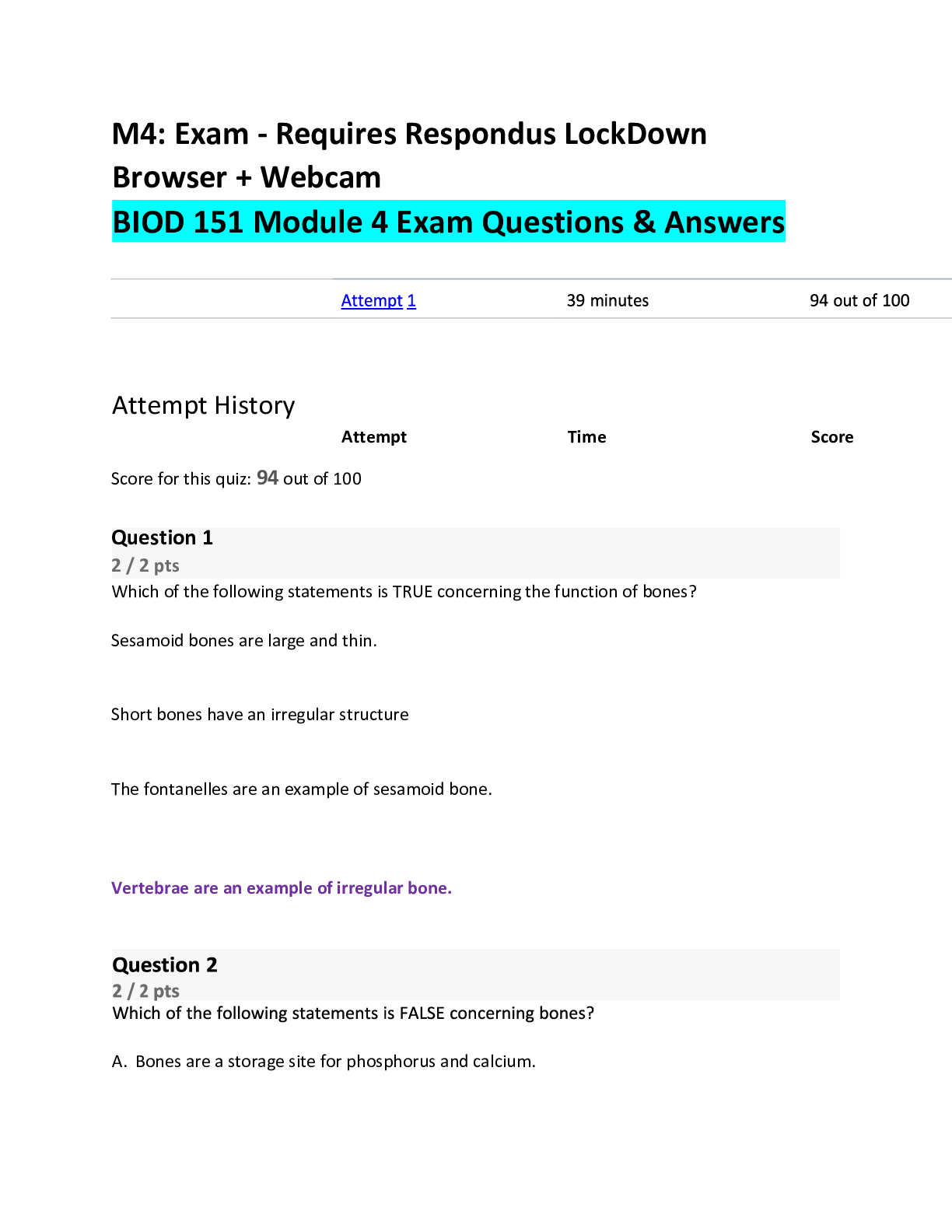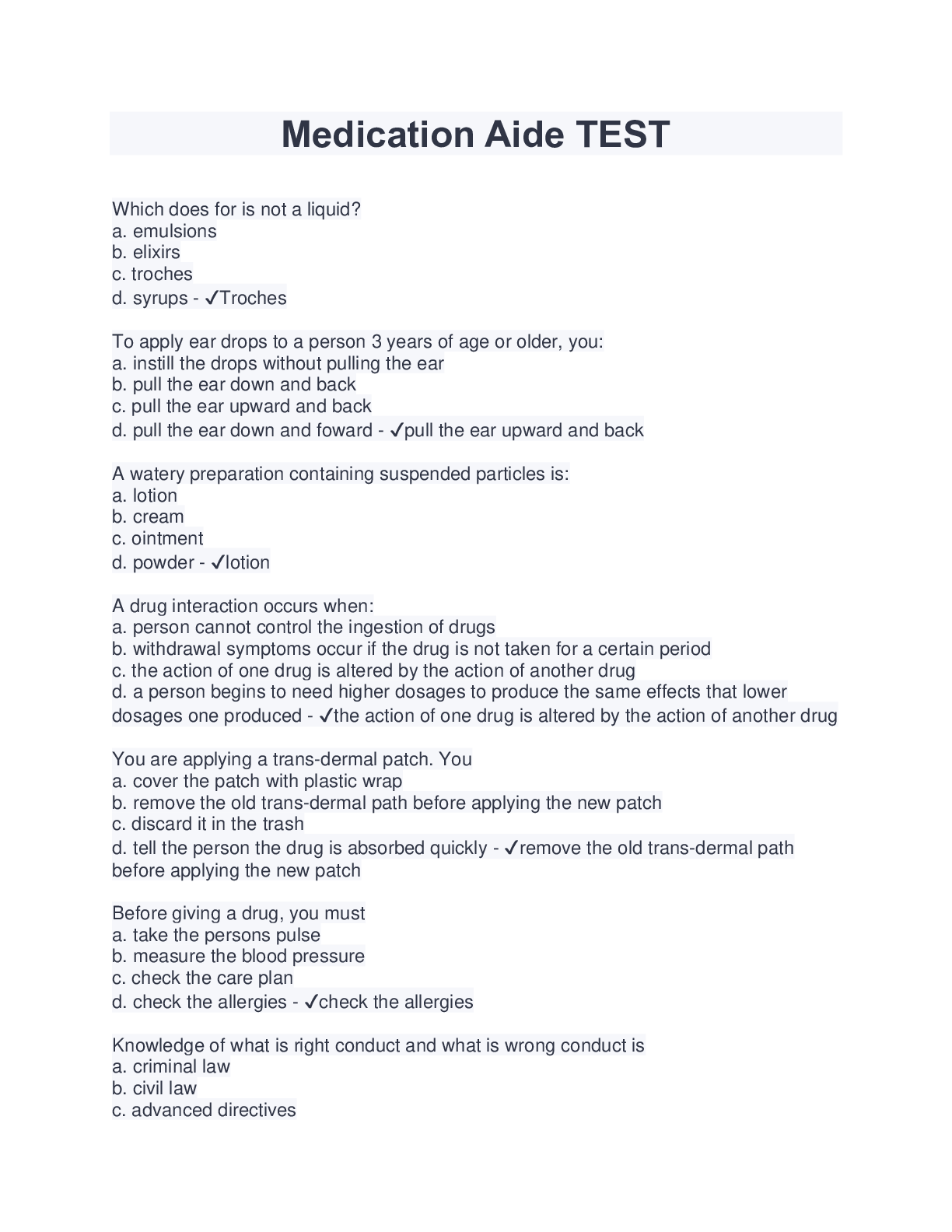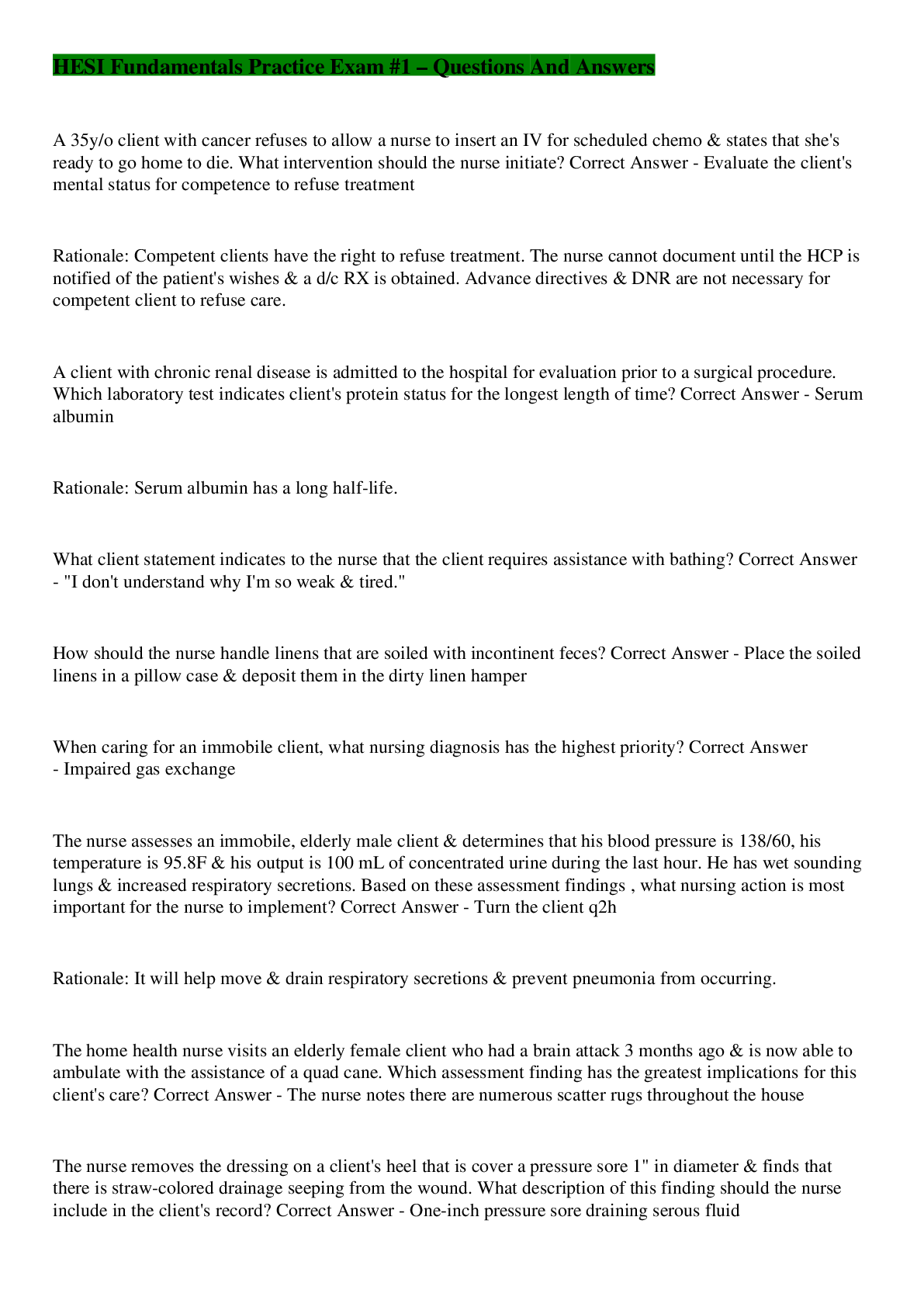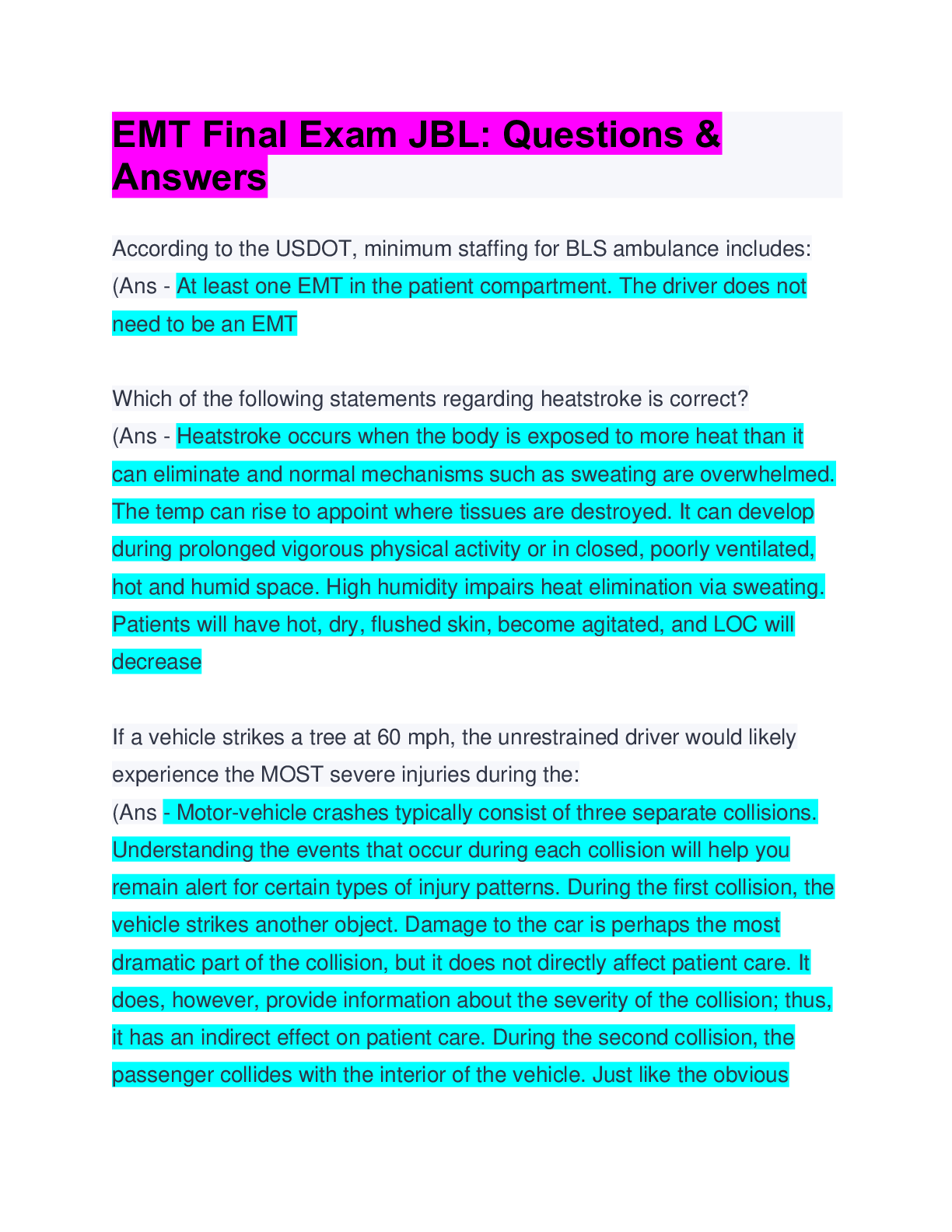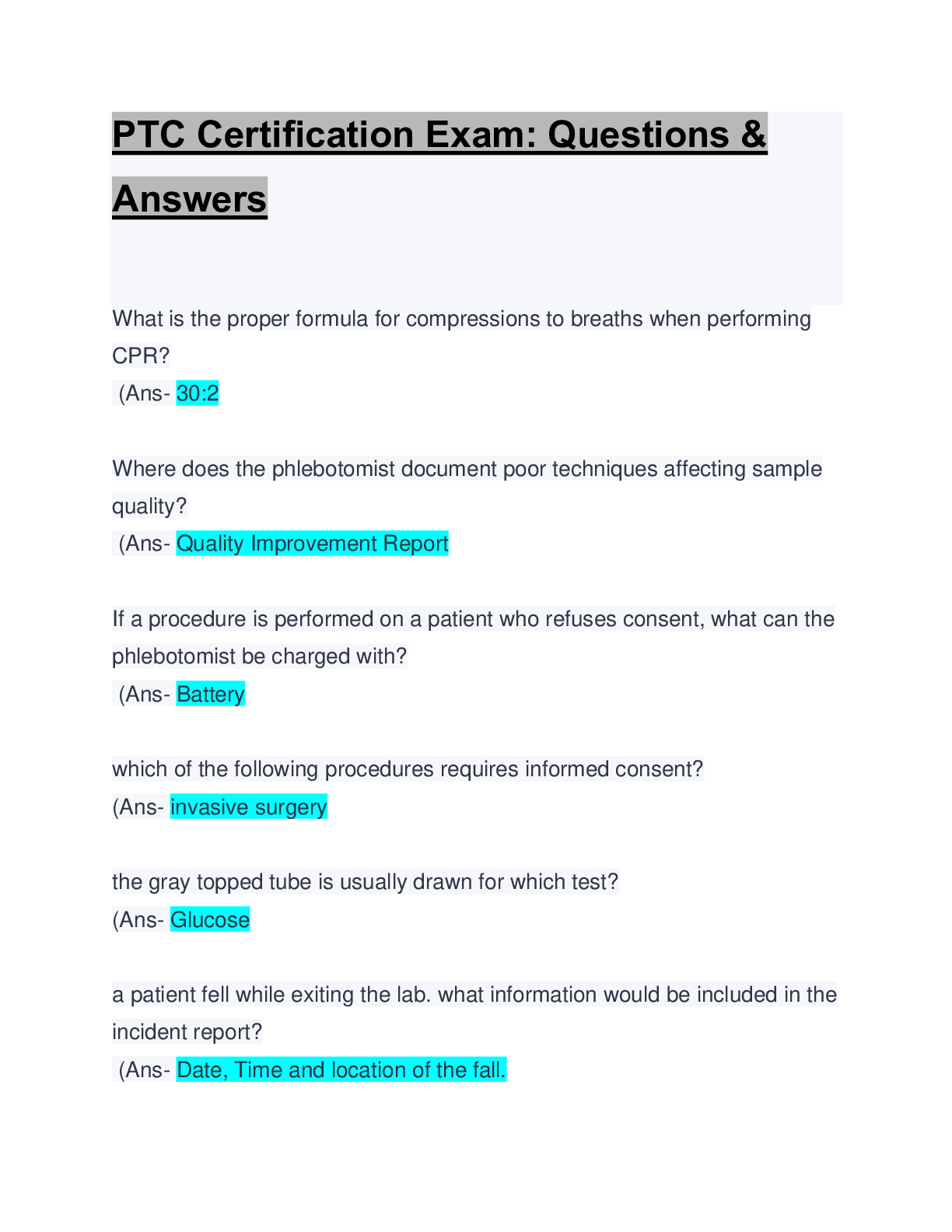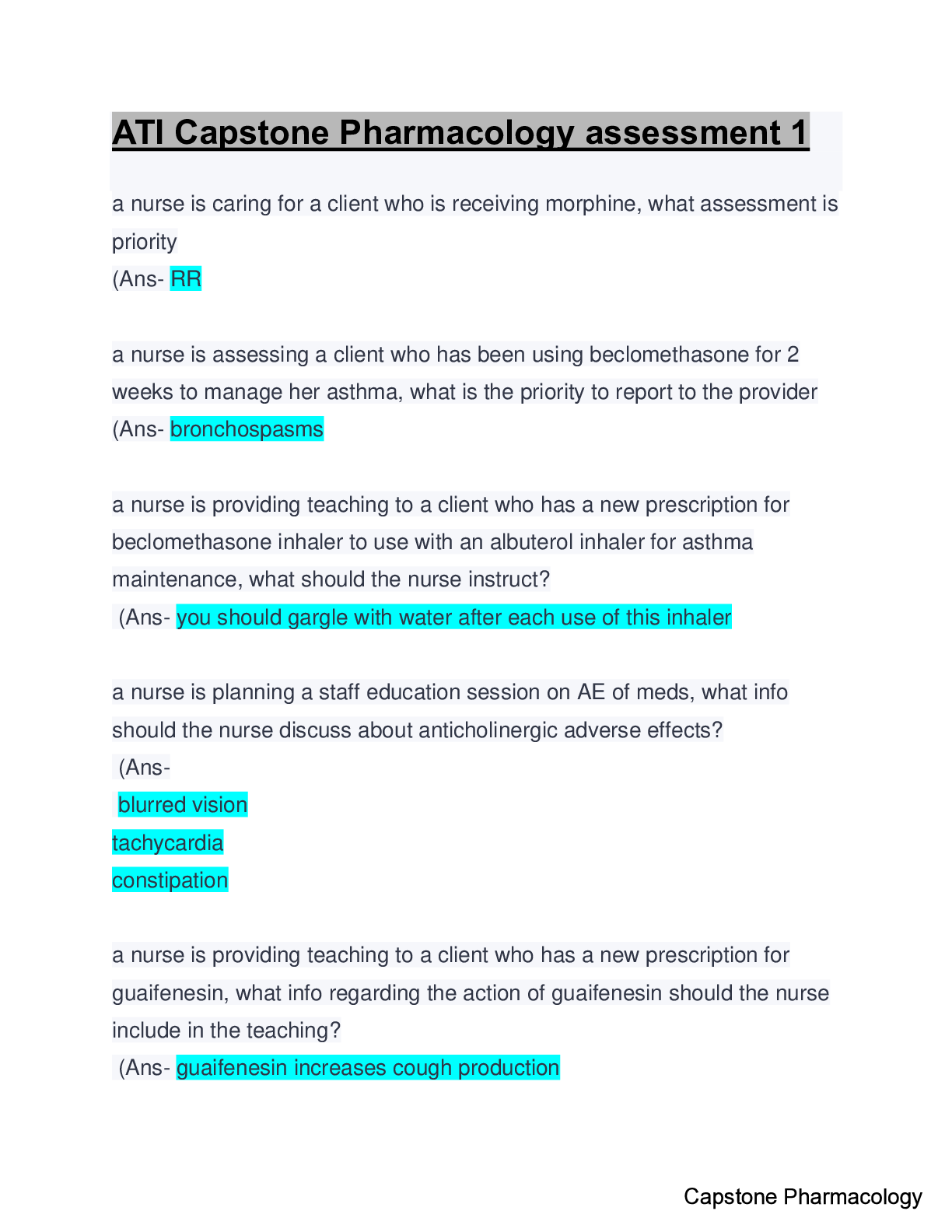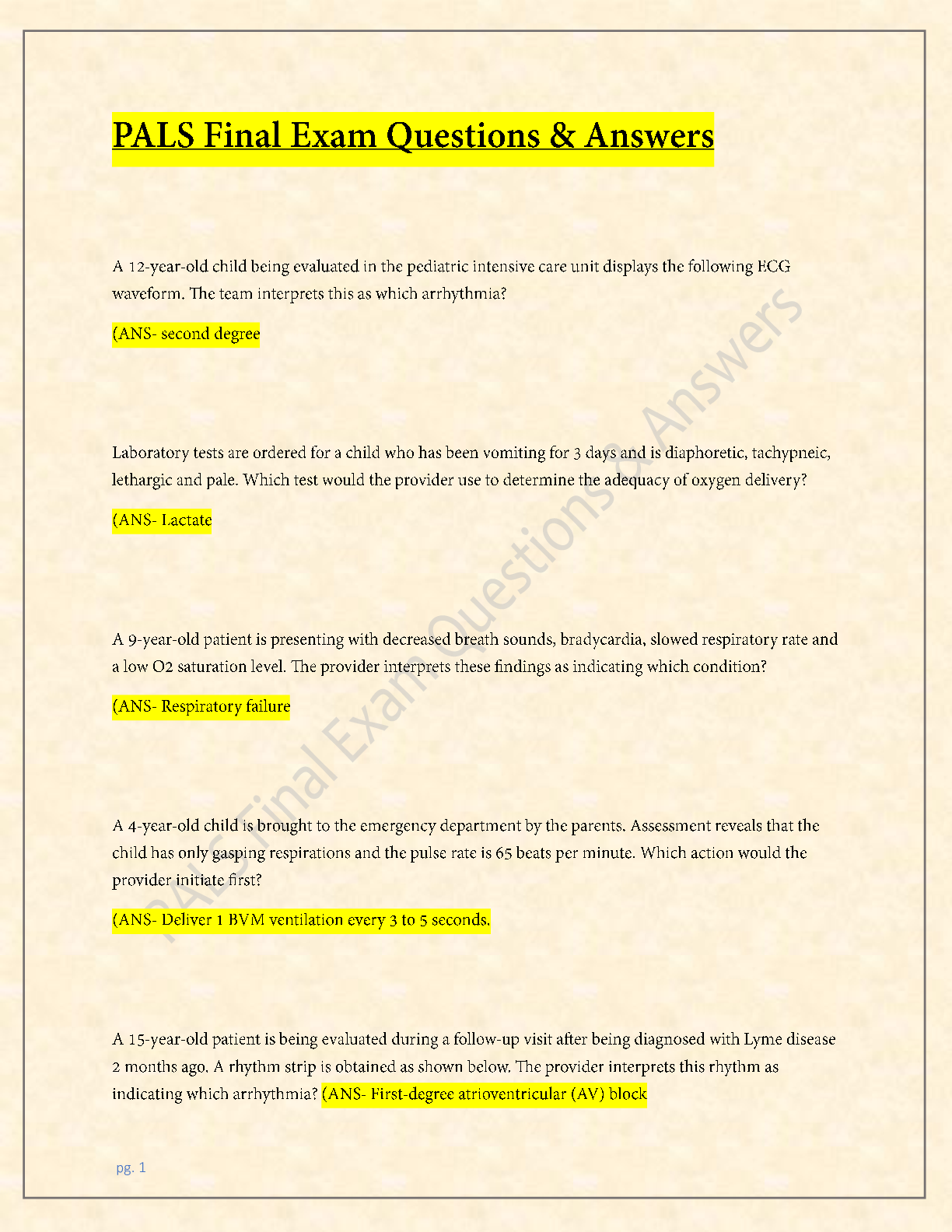Health Care > EXAM > HESI RN Comprehensive Predictor Exam;Questions & Answers; Latest Updated (All)
HESI RN Comprehensive Predictor Exam;Questions & Answers; Latest Updated
Document Content and Description Below
An oriented patient has recently had surgery. Which action is best for the nurse to take to assess this patient's pain? a. Assess the patient's body language. b. Ask the patient to rate the level of... pain. c. Observe the cardiac monitor for increased heart rate. d. Have the patient describe the effect of pain on the ability to co ( ANS: B One of the most subjective and therefore most useful characteristics for reporting pain is its severity. Therefore, the best way to assess a patient's pain is to ask the patient to rate the pain. Nonverbal communication, such as body language, is not as effective in assessing pain, especially when the patient is oriented. Heart rate sometimes increases when a patient is in pain, but this is not a symptom that is specific to pain. Pain sometimes affects a patient's ability to cope, but assessing the effect of pain on coping assesses the patient's ability to cope; it does not assess the patient's pain. A nurse is caring for a patient who recently had abdominal surgery and is experiencing severe pain. The patient's blood pressure is 110/60 mm Hg, and heart rate is 60 beats/min. Additionally, the patient does not appear to be in any distress. Which response by the nurse is most therapeutic? a. "Your vitals do not show that you are having pain; can you describe your pain?" b. "OK, I will go get you some narcotic pain relievers immediately." c. "What would you like to try to alleviate your pain?" d. "You do not look like you are in pain." ( ANS: C Be sure the patient is a partner in making decisions about the best approaches for managing pain. A patient knows the most about his or her pain and is an important partner in selecting successful pain therapies. The nurse must believe that a patient is in pain whenever the patient reports that he or she is in pain, even if the patient does not appear to be in pain. The nurse must be careful to not judge the patient based on vital signs or nonverbal communication and must not assume that the patient is seeking narcotics. The patient is a partner in pain management, so going to get narcotics to treat the pain without consulting with the patient first is not appropriate. A nurse teaches the patient about the gate control theory. Which statement made by a patient reflects a correct understanding about the relationship between the gate control theory of pain and the use of meditation to relieve pain? a. "Meditation controls pain by blocking pain impulses from coming through the gate." b. "Meditation alters the chemical composition of pain neuroregulators, which closes the gate." c. "Meditation will help me sleep through the pain because it opens the gate." d. "Meditation stops the occurrence of pain stimuli." ( ANS: A According to this theory, gating mechanisms located along the central nervous system regulate or block pain impulses. Pain impulses pass through when a gate is open and are blocked when a gate is closed. Nonpharmacologic pain-relief measures, such as meditation, work by closing the gates, which keeps pain impulses from coming through. Meditation does not open pain gates or stop pain from occurring. Meditation also does not have an effect on pain neuroregulators. A nurse is planning care for an older-adult patient who is experiencing pain. Which statement made by the nurse indicates the supervising nurse needs to follow up? a. "As adults age, their ability to perceive pain decreases." b. "Older patients may have low serum albumin in their blood, causing toxic effects of analgesic drugs." c. "Patients who have dementia probably experience pain, and their pain is not always well controlled." d. "It is safe to administer opioids to older adults as long as you start with small doses and frequently assess patient's response to the medication." ( ANS: A Aging does not affect the ability to perceive pain. This misconception must be corrected by the supervising nurse. All the other statements are true and require no follow-up. Opioids are safe to use in older adults as long as they are slowly titrated and the nurse frequently monitors the patient. Patients with dementia most likely experience unrelieved pain because their pain is difficult to assess. Older adults frequently eat poorly, resulting in low serum albumin levels. Many drugs are highly protein bound. In the presence of low serum albumin, more free drug (active form) is available, thus increasing the risk for side and/or toxic effects. The nurse is caring for two patients; both are having a hysterectomy. The first patient is having the hysterectomy after a complicated birth. The second patient has uterine cancer. What will most likely influence the experience of pain for these two patients? a. Meaning of pain b. Neurological factors c. Competency of the surgeon d. Postoperative support personnel ( ANS: A The degree and quality of pain perceived by a patient are related to the meaning of the pain. The patient's perception of pain is influenced by psychological factors, such as anxiety and coping, which in turn influence the patient's experience of pain. Each patient's experience is different. Neurological factors can interrupt or influence pain perception, but neither of these patients is experiencing alterations in neurological function. The knowledge, attitudes, and beliefs of nurses, health care providers, the surgeon, and other health care personnel about pain affect pain management but do not necessarily influence a patient's pain perceptions. The nurse is preparing pain medications. To which patient does the nurse anticipate administering an opioid fentanyl patch? a. A 15-year-old adolescent with a fractured femur b. A 30-year-old adult with cellulitis c. A 50-year-old patient with prostate cancer d. An 80-year-old patient with a broken hip ( ANS: C Transdermal fentanyl (patch), which is 100 times more potent than morphine, is available for opioid- tolerant patients with cancer or chronic pain (prostate cancer). It delivers predetermined doses that provide analgesia for up to 72 hours. The other patients are expected to experience acute pain (fractured femur, cellulitis, and broken hip). Therefore, they will most likely benefit from oral or IV opioids for short-term pain relief. A patient is receiving opioid medication through an epidural infusion. Which action will the nurse take? a. Restrict fluid intake. b. Label the tubing that leads to the epidural catheter. c. Apply a gauze dressing to the epidural catheter insertion site. d. Ask the nursing assistive personnel to check on the patient at least once every 2 hours. ( ANS: B To reduce the accidental administration of IV medications into the epidural catheter, the tubing that leads to the epidural catheter needs to be labeled clearly. The epidural insertion site needs to be covered by a transparent dressing to prevent infection and allow the nurse to assess the site. Patients receiving epidural anesthesia need to be monitored every 15 minutes until stabilized and then at least hourly for 12 to 24 hours. A woman is in labor and refuses to receive any sort of anesthesia medication. Which alternative treatment is best for this patient? a. Transcutaneous electrical nerve stimulation (TENS) b. Herbal supplements with analgesic effects c. Pudendal block (regional anesthesia) d. Relaxation and guided imagery ( ANS: D In the case of a patient in labor, relaxation with guided imagery is often an effective supplement for pain management because it provides women with a sense of control over their pain. Relaxation and guided imagery can be used during any phase of health or illness. TENS units are typically used to manage postsurgical and procedural pain. Herbal supplements need to be evaluated for safety during pregnancy. Additionally, some patients consider herbal supplements to be another form of medication, and they are not typically used to control acute pain. A pudendal block is a type of regional anesthesia (injection or infusion of local anesthetics to block a group of sensory nerve fibers); use of it does not respect the patient's wishes for nonpharmacological pain control. A nurse is teaching a patient about patient-controlled analgesia (PCA). Which statement made by the patient indicates to the nurse that teaching is effective? a. "I will only need to be on this pain medication." b. "I feel less anxiety about the possibility of overdosing." c. "I can receive the pain medication as frequently as I need to." d. "I need the nurse to notify me when it is time for another dose." ( ANS: B A PCA is a device that allows the patient to determine the level of pain relief delivered, reducing the risk of overdose. The PCA infusion pumps are designed to deliver a specific dose that is programmed to be available at specific time intervals (usually in the range of 8 to 15 minutes) when the patient activates the delivery button. A limit on the number of doses per hour or 4-hour interval may also be set. This can help decrease a patient's anxiety related to possible overdose. Its use also often eases anxiety because the patient is not reliant on the nurse for pain relief. Other medications, such as oral analgesics, can be given in addition to the PCA machine. One benefit of PCA is that the patient does not need to rely on the nurse to administer pain medication; the patient determines when to take the medication. A nurse is caring for a patient who is experiencing pain following abdominal surgery. Which information is important for the nurse to share with the patient when providing patient education about effective pain management? a. "To prevent overdose, you need to wait to ask for pain medication until you begin to experience pain." b. "You should take your medication after you walk to make sure you do not fall while you are walking." c. "We should work together to create a schedule to provide regular dosing of medication." d. "When you experience severe pain, you will need to take oral pain medications." ( ANS: C One way to maximize pain relief while potentially decreasing opioid use is to administer analgesics around the clock (ATC) rather than on a prn basis. This approach ensures a more constant therapeutic blood level of an analgesic. Working with the patient to design a schedule allows the patient to be a full partner in the care provided. The nurse should not wait until pain is experienced because it takes medications 10-30 minutes to begin to relieve pain. The nurse administers pain medications before painful activities, such as walking, and administers intravenous medications when a patient is having severe pain. A nurse is caring for a patient who recently h [Show More]
Last updated: 1 year ago
Preview 1 out of 24 pages
Instant download
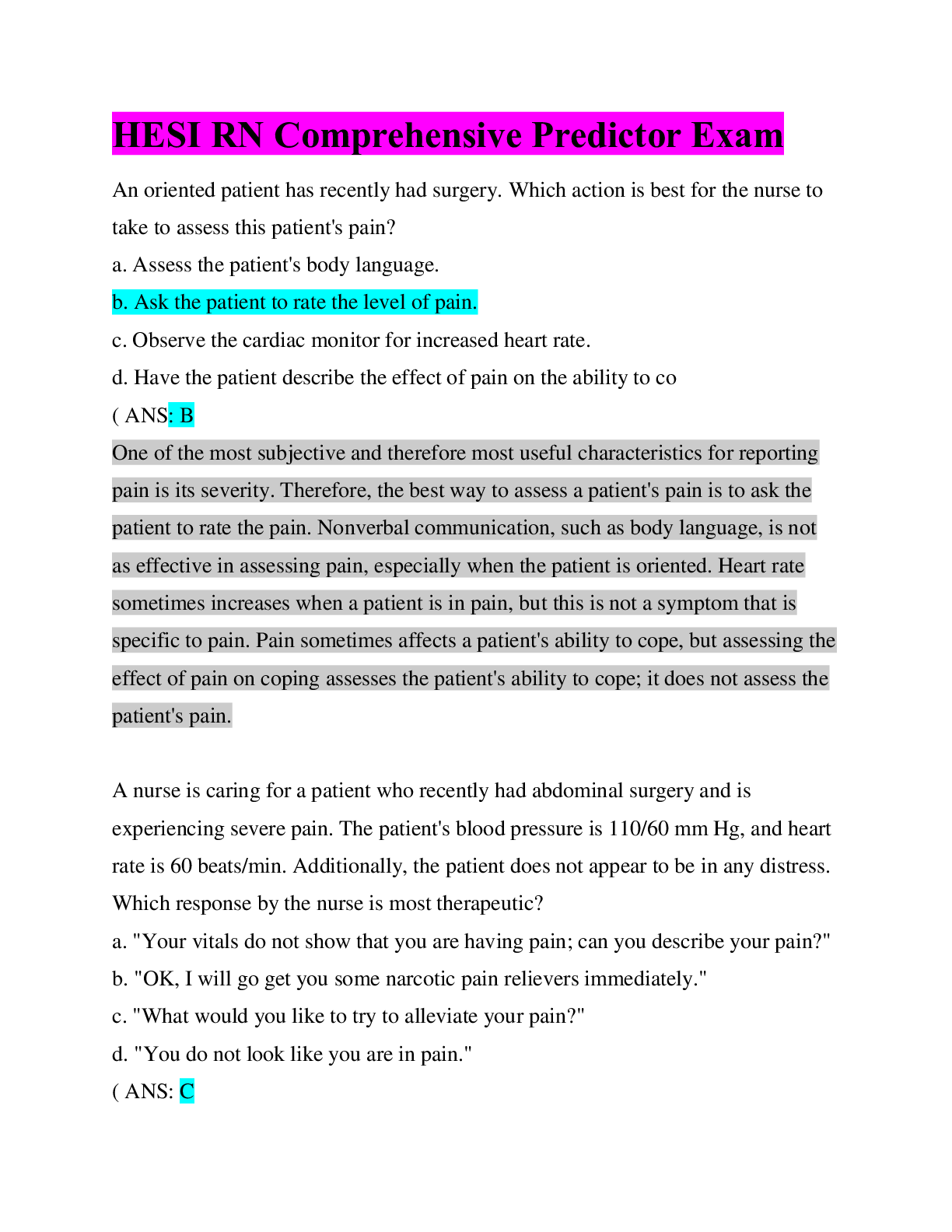
Instant download
Reviews( 0 )
Document information
Connected school, study & course
About the document
Uploaded On
Oct 25, 2022
Number of pages
24
Written in
Additional information
This document has been written for:
Uploaded
Oct 25, 2022
Downloads
0
Views
191



